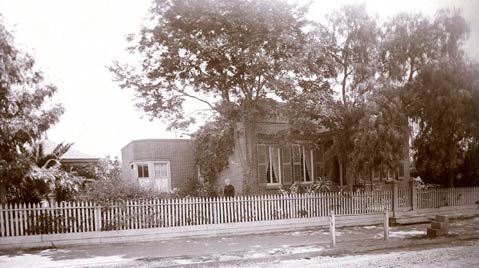Cota-Knox Building
One of the Oldest Brick Structures in Santa One of the Oldest Brick Structures in Santa Barbara

This building, commonly known as the Cota-Knox Building, is one of the oldest brick structures in Santa Barbara. José Lobero constructed it in 1871 for his mother-in-law, Francisca Cota, who was losing her own home to the forces of progress. The house was later purchased by Samuel Knox, one of the city’s most prominent physicians in the early 1900s.
José Lobero, a native of Italy, arrived in Santa Barbara around 1860, after a time in San Luis Obispo, where he made his living as a musician and saloon keeper. In 1862, he married María Clara Lugarda Cota at Mission Santa Inés. She was the granddaughter of Pablo Antonio Cota, who had been a member of Gaspar de Portolá’s expedition to California in 1769, during which the first of the California missions were founded by Junípero Serra. Her father had been property manager for Mission Santa Inés for a number of years.
In 1873, Lobero opened his magnificent adobe opera house on the site of today’s Lobero Theatre. A man of modest financial means, Lobero borrowed $25,000 from W.W. Hollister (after whom Hollister Avenue is named), one of Santa Barbara’s leading entrepreneurs. Lobero also drew upon the resources of his wife’s family to finance the construction of his dream. The theater’s gala opening took place on February 22, with a “Grand Italian Operatic Concert,” directed by Lobero.
Two years prior to this triumphant opening, Lobero had come to the aid of his mother-in-law. Her adobe home lay directly across the proposed route of Anacapa Street, as laid down by the Salisbury Haley survey of 1851. Through the years, the city had methodically razed buildings in order to impose the survey’s street grid on the growing town. Francisca Cota’s home was one of those standing in the way of “progress.”
Lobero arranged to have a modest brick residence built for her at 914 Anacapa Street, about one-half block south of her adobe. Brick was still a fairly rare building material in Santa Barbara at that time. Adobe, which had been the construction material of choice during the Spanish and Mexican eras, was falling out of favor as the city became more Americanized. The home Lobero built for his mother-in-law was among the handful of brick buildings in town, a harbinger of things to come.
The original house was a little more than 900 square feet with five rooms and a small wing projecting out to one side. The house was expanded in ensuing years, including a small Eastlake-style front porch to give the house a Victorian look. Francisca Cota had precious few years to enjoy her new home, for she died in 1877.
Soon after her death, the house came into the possession of Dr. Samuel Budd Page Knox, who used it as a residence and office. A native of Pennsylvania, Knox had served on the Union side in the Civil War and settled in Santa Barbara in 1875. He became a familiar sight around town, in part because he often made his house calls by bicycle. Reportedly, he delivered Thomas Storke, future publisher of the Santa Barbara News-Press. Knox served several terms as chief surgeon at Santa Barbara County General Hospital and was the first president of the Board of Trustees of the Santa Barbara Public Library in 1882.
Upon Knox’s death in 1922, the house passed into the hands of Gertrude Wright, adopted daughter of Knox and his wife. She lived in the house until her 1934 marriage to Joseph Feeley. Feeley was a U.S. Customs official, and the couple lived in the Dominican Republic before returning to Santa Barbara in 1946. They lived in the Cota-Knox house for a short time before relocating to Montecito.
The house became an office building and passed through a number of owners’ hands. In 1975, the present owner, the Santa Barbara Trust for Historic Preservation, acquired the building. Today, the modest appearance of the Cota-Knox Building belies its rich lineage.



